Origin of the Multiple-Sourced Cherts in Maokou Carbonates in Sichuan Basin, South China
Abstract
:1. Introduction
2. Geological Setting
3. Materials and Methods
4. Results
4.1. Petrography of Cherts
4.2. Geochemistry
4.2.1. Major and Trace Elements
4.2.2. Rare Earth Elements
4.2.3. Stable Silicon Isotope Compositions
5. Discussion
5.1. Origin of the Bedded Cherts
5.2. Origin of Nodular Cherts
5.3. The Formation Mechanism of the Maokou Cherts
6. Conclusions
Author Contributions
Funding
Acknowledgments
Conflicts of Interest
References
- Adachi, M.; Yamamoto, K.; Sugisaki, R. Hydrothermal chert and associated siliceous rocks from the northern Pacific their geological significance as indication od ocean ridge activity. Sediment. Geol. 1986, 47, 125–148. [Google Scholar] [CrossRef]
- Kato, Y.; Nakao, K.; Isozaki, Y. Geochemistry of Late Permian to Early Triassic pelagic cherts from southwest Japan: Implications for an oceanic redox change. Chem. Geol. 2002, 182, 15–34. [Google Scholar] [CrossRef]
- Dongying, S.; Wenchen, X. Identification of the Guadalupian–Lopingian boundary in the Permian in a bedded chert sequence, South China. Palaeogeogr. Palaeoclimatol. Palaeoecol. 2006, 236, 272–289. [Google Scholar] [CrossRef]
- Qiu, Z.; Wang, Q. Geochemical evidence for submarine hydrothermal origin of the Middle-Upper Permian chert in Laibin of Guangxi, China. Sci. China Earth Sci. 2011, 54, 1011–1023. [Google Scholar] [CrossRef]
- Dong, Y.; Xu, S.; Wen, L.; Chen, H.; Fu, S.; Zhong, Y.; Wang, J.; Zhu, P.; Cui, Y. Tectonic control of Guadalupian-Lopingian cherts in northwestern Sichuan Basin, South China. Palaeogeogr. Palaeoclim. Palaeoecol. 2020, 557, 109915. [Google Scholar] [CrossRef]
- Murchey, B.L.; Jones, D.L. A mid-Permian chert event: Widespread deposition of biogenic siliceous sediments in coastal, island arc and oceanic basins. Palaeogeogr. Palaeoclim. Palaeoecol. 1992, 96, 161–174. [Google Scholar] [CrossRef]
- Beauchamp, B.; Baud, A. Growth and demise of Permian biogenic chert along northwest Pangea: Evidence for end-Permian collapse of thermohaline circulation. Palaeogeogr. Palaeoclim. Palaeoecol. 2002, 184, 37–63. [Google Scholar] [CrossRef] [Green Version]
- Gates, L.M.; James, N.P.; Beauchamp, B. A glass ramp: Shallow-water Permian spiculitic chert sedimentation, Sverdrup Basin, Arctic Canada. Sediment. Geol. 2004, 168, 125–147. [Google Scholar] [CrossRef]
- Vattanasak, H.; Chonglakmani, C.; Feng, Q.; Morley, C.K. Chert geochemistry, depositional setting, stratigraphic and structural significance for the Permian Nong Pong Formation, Khao Khwang Fold and Thrust Belt, Saraburi, Thailand. J. Asian Earth Sci. 2020, 191, 104234. [Google Scholar] [CrossRef]
- Wu, W.; Liu, W.; Mou, C.; Liu, H.; Qiao, Y.; Pan, J.; Ning, S.; Zhang, X.; Yao, J.; Liu, J. Organic-rich siliceous rocks in the upper Permian Dalong Formation (NW middle Yangtze): Provenance, paleoclimate and paleoenvironment. Mar. Pet. Geol. 2020, 123, 104728. [Google Scholar] [CrossRef]
- Kametaka, M.; Takebe, M.; Nagai, H.; Zhu, S.; Takayanagi, Y. Sedimentary environments of the Middle Permian phosphorite–chert complex from the northeastern Yangtze platform, China; the Gufeng Formation: A continental shelf radiolarian chert. Sediment. Geol. 2005, 174, 197–222. [Google Scholar] [CrossRef]
- Yao, X.; Zhou, Y.; Li, S.; Li, D. Research status and advances in chert and Permian chert event. Adv. Earth Sci. 2013, 28, 1189–1200. [Google Scholar]
- Liao, Z.-W.; Hu, W.-X.; Fu, X.-G.; Hu, Z.-Y. Geochemistry of upper Permian siliceous rocks from the Lower Yangtze region, southeastern China: Implications for the origin of chert and Permian ocean chemistry. Pet. Sci. 2018, 16, 252–266. [Google Scholar] [CrossRef] [Green Version]
- Yu, Y.; Lin, L.; Deng, X.; Wang, Y.; Li, Y.; Guo, Y. Geochemical features of the Middle–Upper Permian cherts and implications for origin, depositional environment in the Sichuan Basin, SW China. Geol. J. 2020, 55, 1493–1506. [Google Scholar] [CrossRef]
- Tréguer, P.; Nelson, D.M.; Van Bennekom, A.J.; DeMaster, D.J.; Leynaert, A.; Quéguiner, B. The Silica Balance in the World Ocean: A Reestimate. Science 1995, 268, 375–379. [Google Scholar] [CrossRef]
- Bostrom, K.; Peterson, M.N.A.; Joensuu, O.; Fisher, D.E. Aluminum-poor ferromanganoan sediments on active oceanic ridges. J. Geophys. Res. Space Phys. 1969, 74, 3261–3270. [Google Scholar] [CrossRef]
- Yamamoto, K. Geochemical characteristics and depositional environments of cherts and associated rocks in the Franciscan and Shimanto Terranes. Sediment. Geol. 1987, 52, 65–108. [Google Scholar] [CrossRef]
- Maliva, R.G.; Knoll, A.H.; Siever, R. Secular Change in Chert Distribution: A Reflection of Evolving Biological Participation in the Silica Cycle. Palaios 1989, 4, 519. [Google Scholar] [CrossRef]
- Yu, K.; Zhang, Z.; Cao, Y.; Qiu, L.; Zhou, C.; Cheng, D.; Sun, P.; Yang, Y. Origin of biogenic-induced cherts from Permian alkaline saline lake deposits in the NW Junggar Basin, NW China: Implications for hydrocarbon exploration. J. Asian Earth Sci. 2021, 211, 104712. [Google Scholar] [CrossRef]
- Matysik, M.; Stemmerik, L.; Olaussen, S.; Rameil, N.; Gianotten, I.P.; Brunstad, H. Cherts, spiculites, and collapse breccias–Porosity generation in upper Permian reservoir rocks, Gohta discovery, Loppa High, south-western Barents Sea. Mar. Pet. Geol. 2021, 128, 105043. [Google Scholar] [CrossRef]
- Yao, X.; Li, S.; Zhou, Y.; Hinnov, L.A. Hydrothermal Origin of Early Permian Chert Nodules in the Central North China Craton Linked to Northern Margin Cratonic Activation. Acta Geol. Sin. 2021, 95, 541–557. [Google Scholar] [CrossRef]
- Gao, P.; He, Z.; Lash, G.G.; Li, S.; Xiao, X.; Han, Y.; Zhang, R. Mixed seawater and hydrothermal sources of nodular chert in Middle Permian limestone on the eastern Paleo-Tethys margin (South China). Palaeogeogr. Palaeoclim. Palaeoecol. 2020, 551, 109740. [Google Scholar] [CrossRef]
- Kamata, Y.; Maezawa, A.; Hara, H.; Ueno, K.; Hisada, K.-I.; Sardsud, A.; Charoentitirat, T.; Charusiri, P. Basaltic activity preserved in an Upper Permian radiolarian chert from the Paleo-Tethys in the Inthanon Zone, northern Thailand. J. Asian Earth Sci. 2012, 61, 51–61. [Google Scholar] [CrossRef]
- Zhu, Z.-Y.; Jiang, S.-Y.; Liu, G.-X.; Zhao, K.-D. Precise dating of the Middle Permian: Zircon U–Pb geochronology from volcanic ash beds in the basal Gufeng Formation, Yangtze region, South China. Gondwana Res. 2013, 23, 1599–1606. [Google Scholar] [CrossRef]
- Wignall, P.B.; Sun, Y.; Bond, D.P.G.; Izon, G.; Newton, R.J.; Védrine, S.; Widdowson, M.; Ali, J.R.; Lai, X.; Jiang, H.; et al. Volcanism, Mass Extinction, and Carbon Isotope Fluctuations in the Middle Permian of China. Science 2009, 324, 1179–1182. [Google Scholar] [CrossRef]
- Huang, J.; Liu, J.; Zhang, Y.; Chang, H.; Shen, Y.; Huang, F.; Qin, L. Cr isotopic composition of the Laobao cherts during the Ediacaran–Cambrian transition in South China. Chem. Geol. 2018, 482, 121–130. [Google Scholar] [CrossRef]
- He, D.; Li, D.; Zhang, G.; Zhao, L.; Fan, C.; Lu, R.; Wen, Z. Formation and evolution of multi-cycle superposed Sichuan Basin, China. Chin. J. Geol. 2011, 46, 589–606. [Google Scholar]
- Zheng, H.; Liu, B. Structural Differentiation and Sedimentary System of the Permian Sichuan Cratonic Basin; René, M., Aiello, G., el Bahariya, G., Eds.; IntechOpen: London, UK, 2020; p. 189. [Google Scholar]
- Shellnutt, J.G. The Emeishan large igneous province: A synthesis. Geosci. Front. 2014, 5, 369–394. [Google Scholar] [CrossRef] [Green Version]
- He, B.; Xu, Y.-G.; Guan, J.-P.; Zhong, Y.-T. Paleokarst on the top of the Maokou Formation: Further evidence for domal crustal uplift prior to the Emeishan flood volcanism. Lithos 2010, 119, 1–9. [Google Scholar] [CrossRef]
- He, B.; Xu, Y.-G.; Chung, S.-L.; Xiao, L.; Wang, Y. Sedimentary evidence for a rapid, kilometer-scale crustal doming prior to the eruption of the Emeishan flood basalts. Earth Planet. Sci. Lett. 2003, 213, 391–405. [Google Scholar] [CrossRef]
- Zhu, B.; Guo, Z.; Zhang, S.; Ukstins, I.; Du, W.; Liu, R. What triggered the early-stage eruption of the Emeishan large igneous province? Bulletin 2019, 131, 1837–1856. [Google Scholar] [CrossRef]
- Zheng, H.; Ma, Y.; Chi, G.; Qing, H.; Liu, B.; Zhang, X.; Shen, Y.; Liu, J.; Wang, Y. Stratigraphic and Structural Control on Hydrothermal Dolomitization in the Middle Permian Carbonates, Southwestern Sichuan Basin (China). Minerals 2019, 9, 32. [Google Scholar] [CrossRef] [Green Version]
- Scotese, C.; Schettino, A. Late Permian-Early Jurassic paleogeography of western Tethys and the world. In Permo-Triassic Salt Provinces of Europe, North Africa and the Atlantic Margins; Elsevier: Amsterdam, The Netherlands, 2017; pp. 57–95. [Google Scholar]
- Wei, H.; Wei, X.; Qiu, Z.; Song, H.; Shi, G. Redox conditions across the G–L boundary in South China: Evidence from pyrite morphology and sulfur isotopic compositions. Chem. Geol. 2016, 440, 1–14. [Google Scholar] [CrossRef]
- Zhang, B.; Yao, S.; Wignall, P.B.; Hu, W.; Ding, H.; Liu, B.; Ren, Y. Widespread coastal upwelling along the Eastern Paleo-Tethys Margin (South China) during the Middle Permian (Guadalupian): Implications for organic matter accumulation. Mar. Pet. Geol. 2018, 97, 113–126. [Google Scholar] [CrossRef]
- Li, M. Report on Natural Gas Exploration and Development Prospect of Sichuan Basin Predicted by Magnetic and Gravity Data; Geophysical Prospecting Team of Sichuan Bureau of Geology and Mineral Resources: Chengdu, China, 1995. [Google Scholar]
- Yang, Y.; Yang, Y.; Wen, L.; Zhang, X.; Chen, C.; Chen, K.; Zhang, Y.; Di, G.; Wang, H.; Xie, C. New progress and prospect of Middle Permian natural gas exploration in the Sichuan Basin. Nat. Gas Ind. B 2021, 8, 35–47. [Google Scholar] [CrossRef]
- McLennan, S.M. Rare earth elements in sedimentary rocks: Influence of provenance and sedimentary processes. Rev. Mineral. Geochem. 1989, 21, 169–200. [Google Scholar]
- Li, D.; Bancroft, G.M.; Fleet, M.E.; Feng, X.H. Silicon K-edge XANES spectra of silicate minerals. Phys. Chem. Miner. 1995, 22, 115–122. [Google Scholar] [CrossRef]
- Ding, T.; Wan, D.; Wang, C.; Zhang, F. Silicon isotope compositions of dissolved silicon and suspended matter in the Yangtze River, China. Geochim. Cosmochim. Acta 2004, 68, 205–216. [Google Scholar] [CrossRef]
- Li, Y.; Hou, K.; Wan, D.; Zhang, Z.; Yue, G. Precambrian banded iron formations in the North China Craton: Silicon and oxygen isotopes and genetic implications. Ore Geol. Rev. 2014, 57, 299–307. [Google Scholar] [CrossRef]
- Lin, L.B.; Chen, H.D.; Zhu, L.D. The origin and geochemical characteristics of Maokou Formation silicalites in the eastern Sichuan Basin. Acta Geol. Sin. 2010, 84, 500–507. [Google Scholar]
- Liu, Z.; Zhuang, X.G.; Teng, G.E.; Xie, X.M.; Yin, L.M.; Bian, L.Z.; Feng, Q.L.; Algeo, T.J. The Lower Cambrian Niutitang Formation at Yangtiao (Guizhou, Sw China): Organic Matter Enrichment, Source Rock Potential, and Hydrothermal Influences. J. Pet. Geol. 2015, 38, 411–432. [Google Scholar] [CrossRef]
- Aitchison, J.; Flood, P. Geochemical constraints on the depositional setting of Palaeozoic cherts from the New England orogen, NSW, eastern Australia. Mar. Geol. 1990, 94, 79–95. [Google Scholar] [CrossRef]
- Abraham, K.; Hofmann, A.; Foley, S.; Cardinal, D.; Harris, C.; Barth, M.; André, L. Coupled silicon–oxygen isotope fractionation traces Archaean silicification. Earth Planet. Sci. Lett. 2010, 301, 222–230. [Google Scholar] [CrossRef]
- Oelze, M.; von Blanckenburg, F.; Hoellen, D.; Dietzel, M.; Bouchez, J. Si stable isotope fractionation during adsorption and the competition between kinetic and equilibrium isotope fractionation: Implications for weathering systems. Chem. Geol. 2014, 380, 161–171. [Google Scholar] [CrossRef] [Green Version]
- Oelze, M.; von Blanckenburg, F.; Bouchez, J.; Hoellen, D.; Dietzel, M. The effect of Al on Si isotope fractionation investigated by silica precipitation experiments. Chem. Geol. 2015, 397, 94–105. [Google Scholar] [CrossRef] [Green Version]
- Geilert, S.; Vroon, P.Z.; Roerdink, D.; Van Cappellen, P.; van Bergen, M.J. Silicon isotope fractionation during abiotic silica precipitation at low temperatures: Inferences from flow-through experiments. Geochim. Cosmochim. Acta 2014, 142, 95–114. [Google Scholar] [CrossRef]
- Geilert, S.; Vroon, P.Z.; Keller, N.S.; Gudbrandsson, S.; Stefánsson, A.; van Bergen, M.J. Silicon isotope fractionation during silica precipitation from hot-spring waters: Evidence from the Geysir geothermal field, Iceland. Geochim. Cosmochim. Acta 2015, 164, 403–427. [Google Scholar] [CrossRef]
- De La Rocha, C.L.; Brzezinski, M.A.; Deniro, M.J.; Shemesh, A. Silicon-isotope composition of diatoms as an indicator of past oceanic change. Nature 1998, 395, 680–683. [Google Scholar] [CrossRef]
- Murray, R.W. Chemical criteria to identify the depositional environment of chert: General principles and applications. Sediment. Geol. 1994, 90, 213–232. [Google Scholar] [CrossRef]
- Bau, M. Rare-earth element mobility during hydrothermal and metamorphic fluid-rock interaction and the significance of the oxidation state of europium. Chem. Geol. 1991, 93, 219–230. [Google Scholar] [CrossRef]
- Bolhar, R.; Van Kranendonk, M. A non-marine depositional setting for the northern Fortescue Group, Pilbara Craton, inferred from trace element geochemistry of stromatolitic carbonates. Precambrian Res. 2007, 155, 229–250. [Google Scholar] [CrossRef]
- Tostevin, R.; Shields, G.A.; Tarbuck, G.M.; He, T.; Clarkson, M.; Wood, R.A. Effective use of cerium anomalies as a redox proxy in carbonate-dominated marine settings. Chem. Geol. 2016, 438, 146–162. [Google Scholar] [CrossRef] [Green Version]
- He, B.; Xu, Y.-G.; Huang, X.-L.; Luo, Z.-Y.; Shi, Y.-R.; Yang, Q.-J.; Yu, S.-Y. Age and duration of the Emeishan flood volcanism, SW China: Geochemistry and SHRIMP zircon U–Pb dating of silicic ignimbrites, post-volcanic Xuanwei Formation and clay tuff at the Chaotian section. Earth Planet. Sci. Lett. 2007, 255, 306–323. [Google Scholar] [CrossRef]
- Sweere, T.; Boorn, S.V.D.; Dickson, A.J.; Reichart, G.-J. Definition of new trace-metal proxies for the controls on organic matter enrichment in marine sediments based on Mn, Co, Mo and Cd concentrations. Chem. Geol. 2016, 441, 235–245. [Google Scholar] [CrossRef]
- Shang, F.; Zhu, Y.; Hu, Q.; Wang, Y.; Li, Y.; Li, W.; Liu, R.; Gao, H. Factors controlling organic-matter accumulation in the Upper Ordovician-Lower Silurian organic-rich shale on the northeast margin of the Upper Yangtze platform: Evidence from petrographic and geochemical proxies. Mar. Pet. Geol. 2020, 121, 104597. [Google Scholar] [CrossRef]
- Nakagawa, S.; Santos, E. Methodological issues and advances in biological meta-analysis. Evol. Ecol. 2012, 26, 1253–1274. [Google Scholar] [CrossRef]
- Saitoh, M.; Isozaki, Y.; Ueno, Y.; Yoshida, N.; Yao, J.; Ji, Z. Middle–Upper Permian carbon isotope stratigraphy at Chaotian, South China: Pre-extinction multiple upwelling of oxygen-depleted water onto continental shelf. J. Asian Earth Sci. 2013, 67–68, 51–62. [Google Scholar] [CrossRef]
- Vogt, P.R. Volcanogenic upwelling of anoxic, nutrient-rich water: A possible factor in carbonate-bank/reef demise and benthic faunal extinctions? Geol. Soc. Am. Bull. 1989, 101, 1225–1245. [Google Scholar] [CrossRef]
- Racki, G.; Cordey, F. Radiolarian palaeoecology and radiolarites: Is the present the key to the past? Earth-Sci. Rev. 2000, 52, 83–120. [Google Scholar] [CrossRef]
- Wilson, B.; Hayek, L.-A.C. Planktonic foraminifera as indicators of oceanographic complexity on the southern Caribbean Sea continental shelf. Estuar. Coast. Shelf Sci. 2019, 228, 106359. [Google Scholar] [CrossRef]
- Rosenbauer, R.J.; Bischoff, J.L. Uptake and transport of heavy metals by heated seawater: A summary of the experimental results. In Hydrothermal Processes at Seafloor Spreading Centers; Springer: Berlin, Germany; pp. 177–197.
- Moore, T.C., Jr. Biogenic silica and chert in the Pacific Ocean. Geology 2008, 36, 975–978. [Google Scholar] [CrossRef]
- Shen, B.; Ma, H.; Ye, H.; Lang, X.; Pei, H.; Zhou, C.; Zhang, S.; Yang, R. Hydrothermal origin of syndepositional chert bands and nodules in the Mesoproterozoic Wumishan Formation: Implications for the evolution of Mesoproterozoic cratonic basin, North China. Precambrian Res. 2018, 310, 213–228. [Google Scholar] [CrossRef]
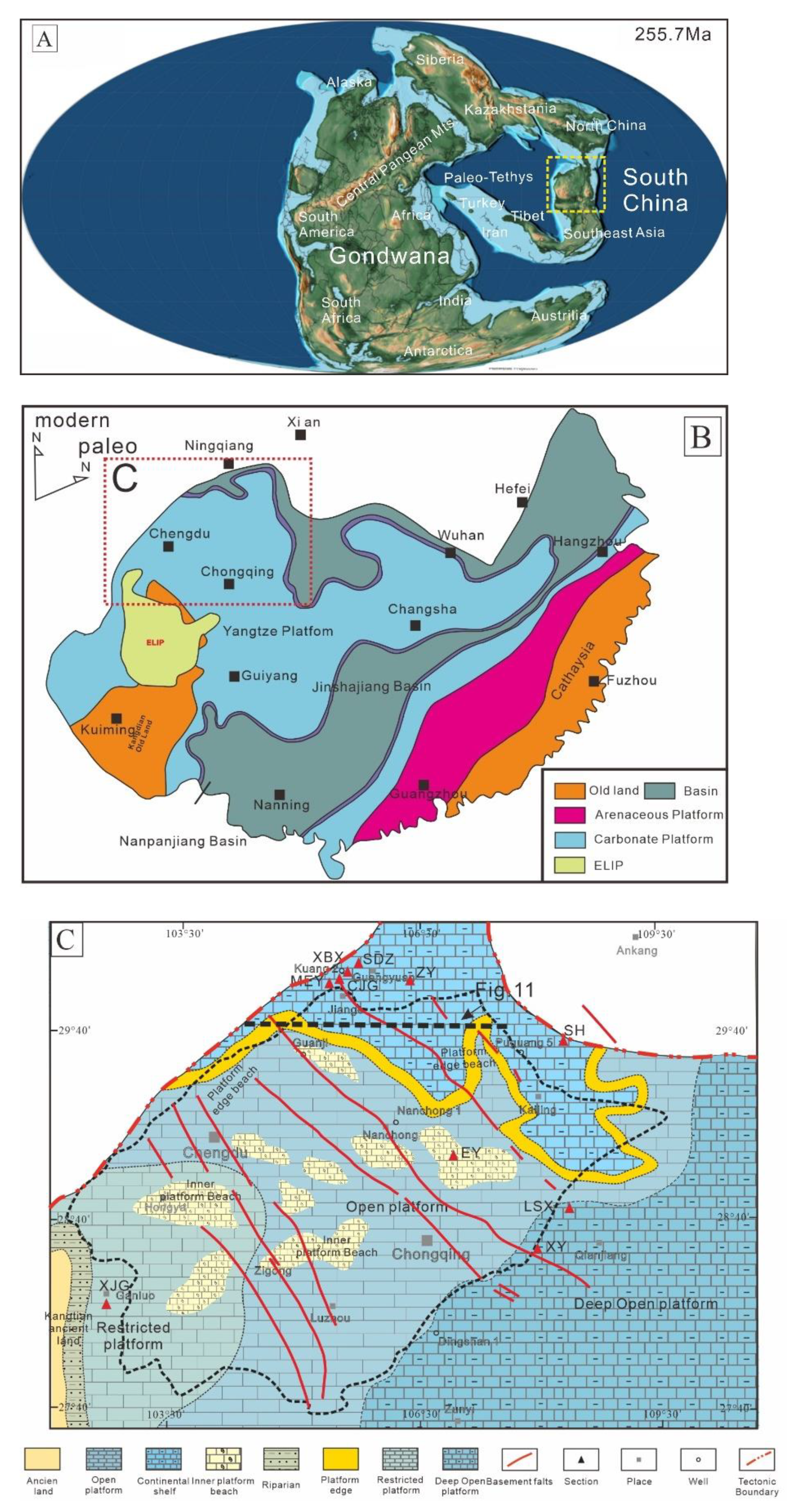
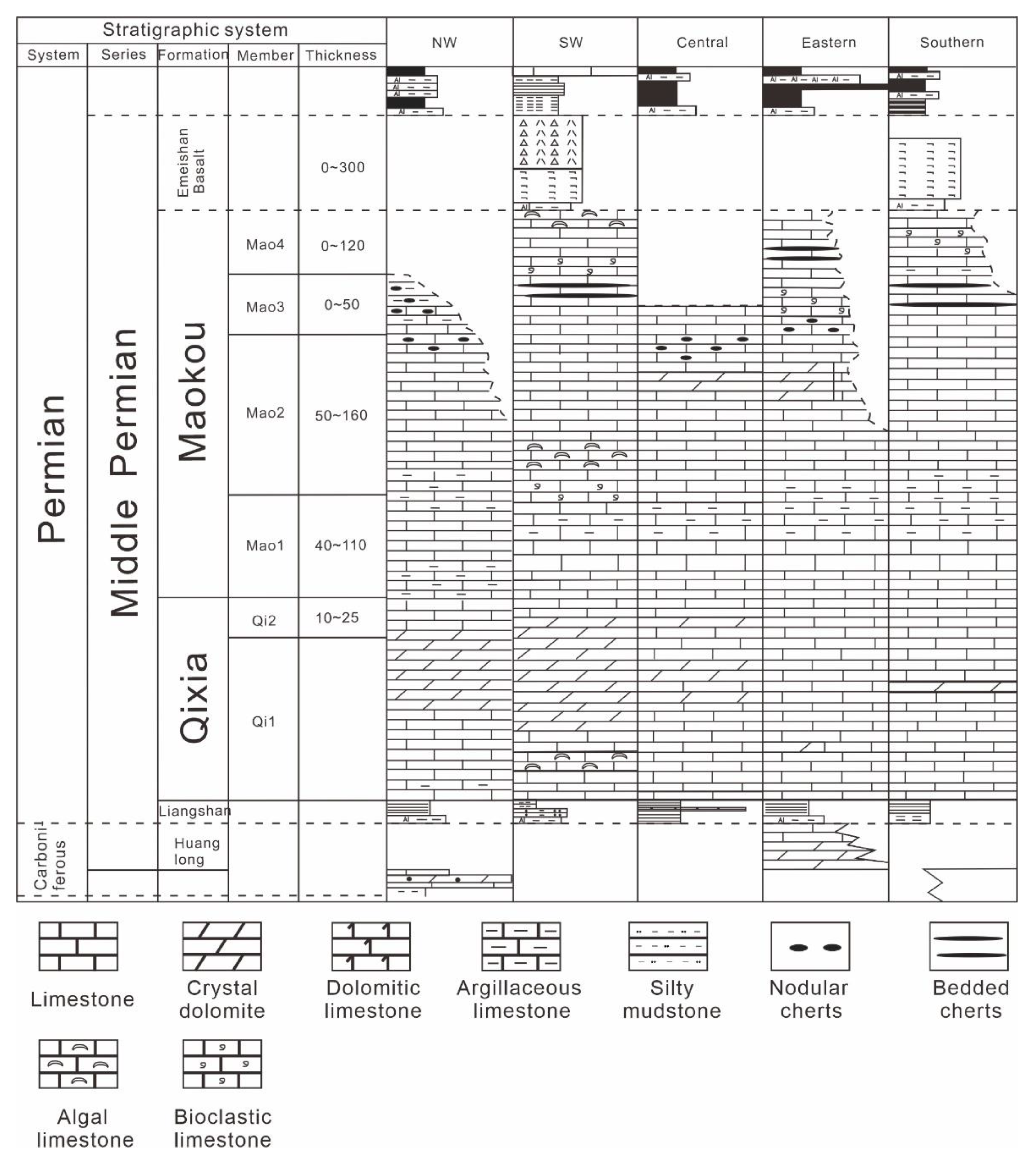
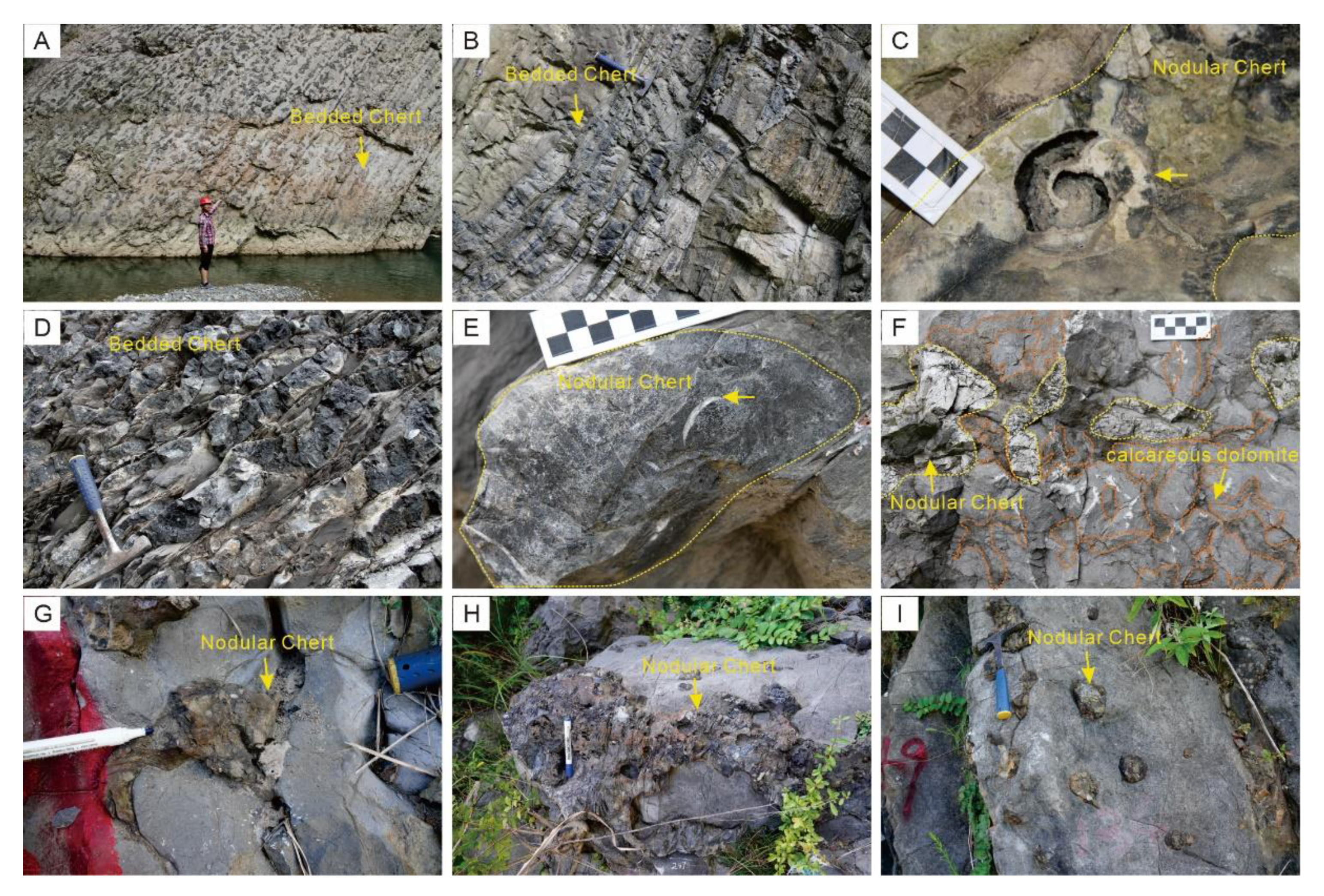
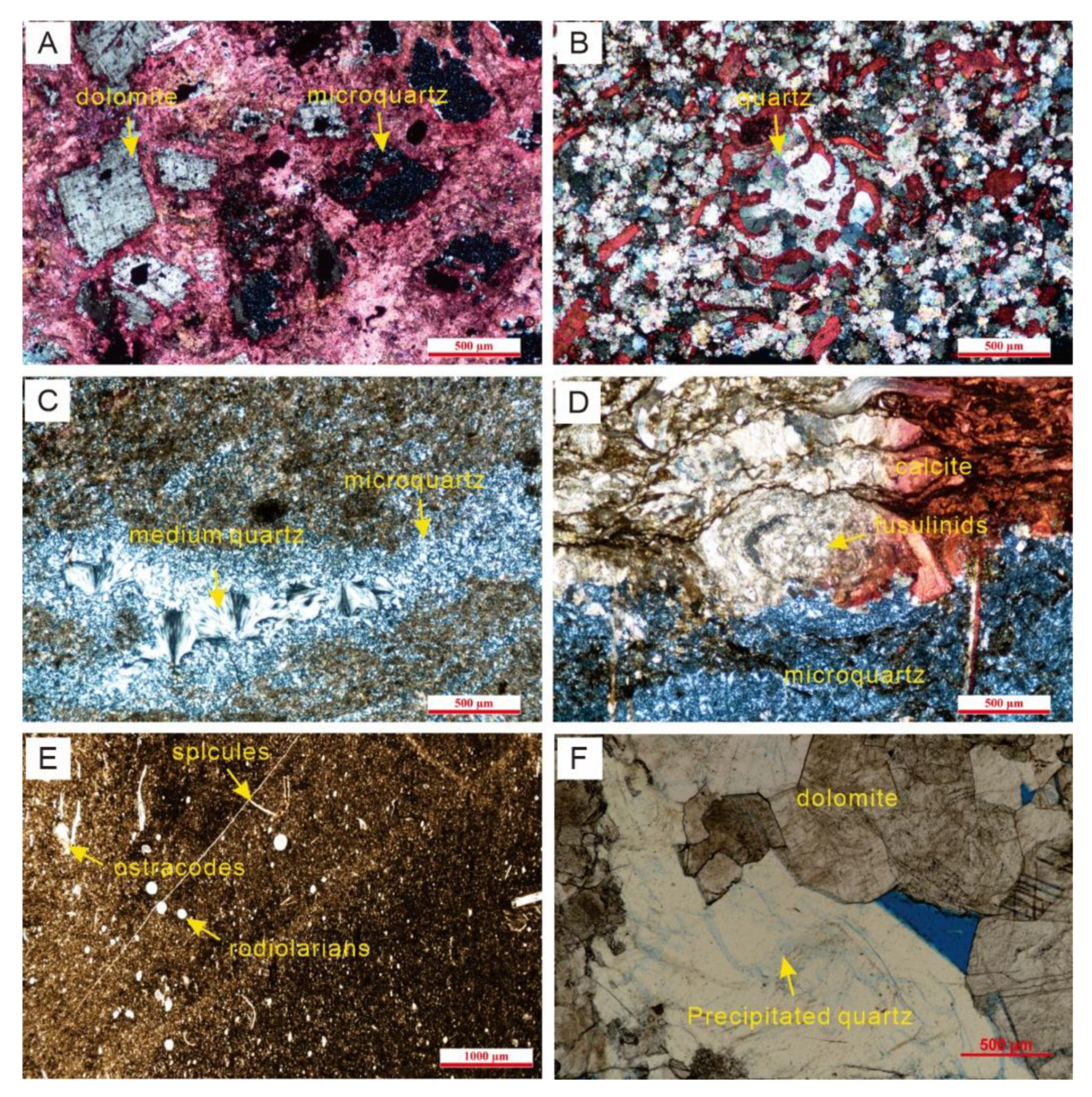

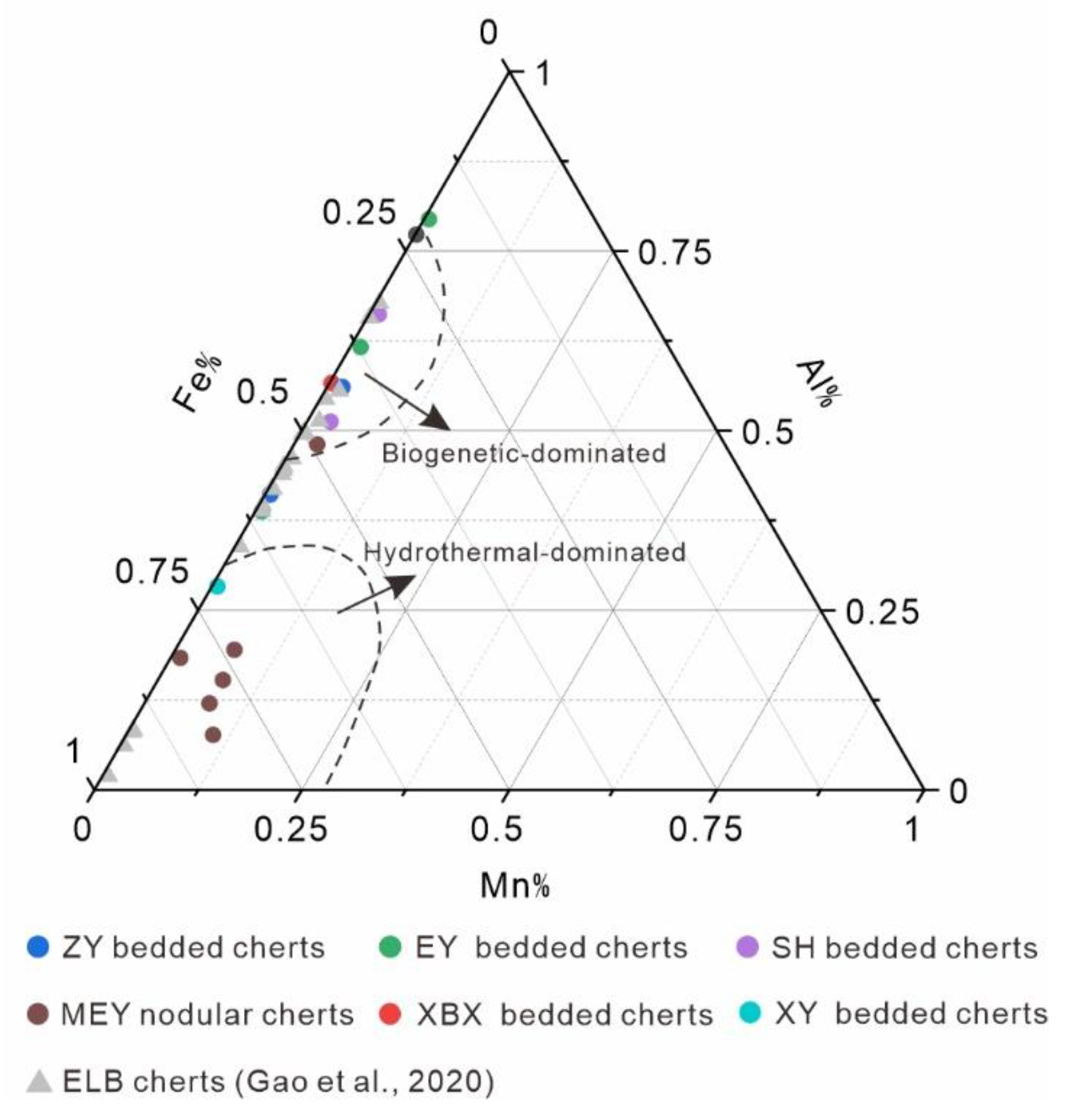
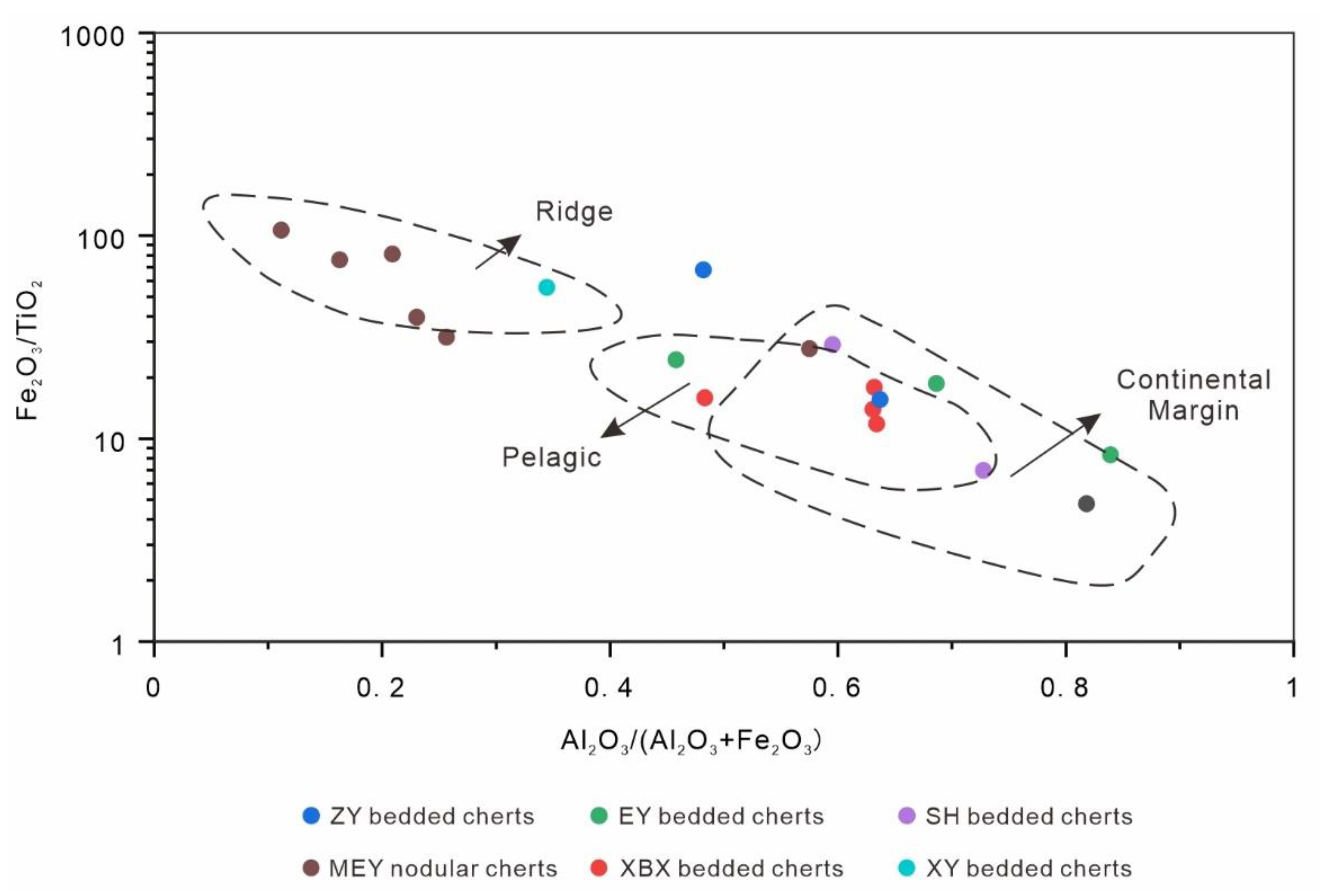

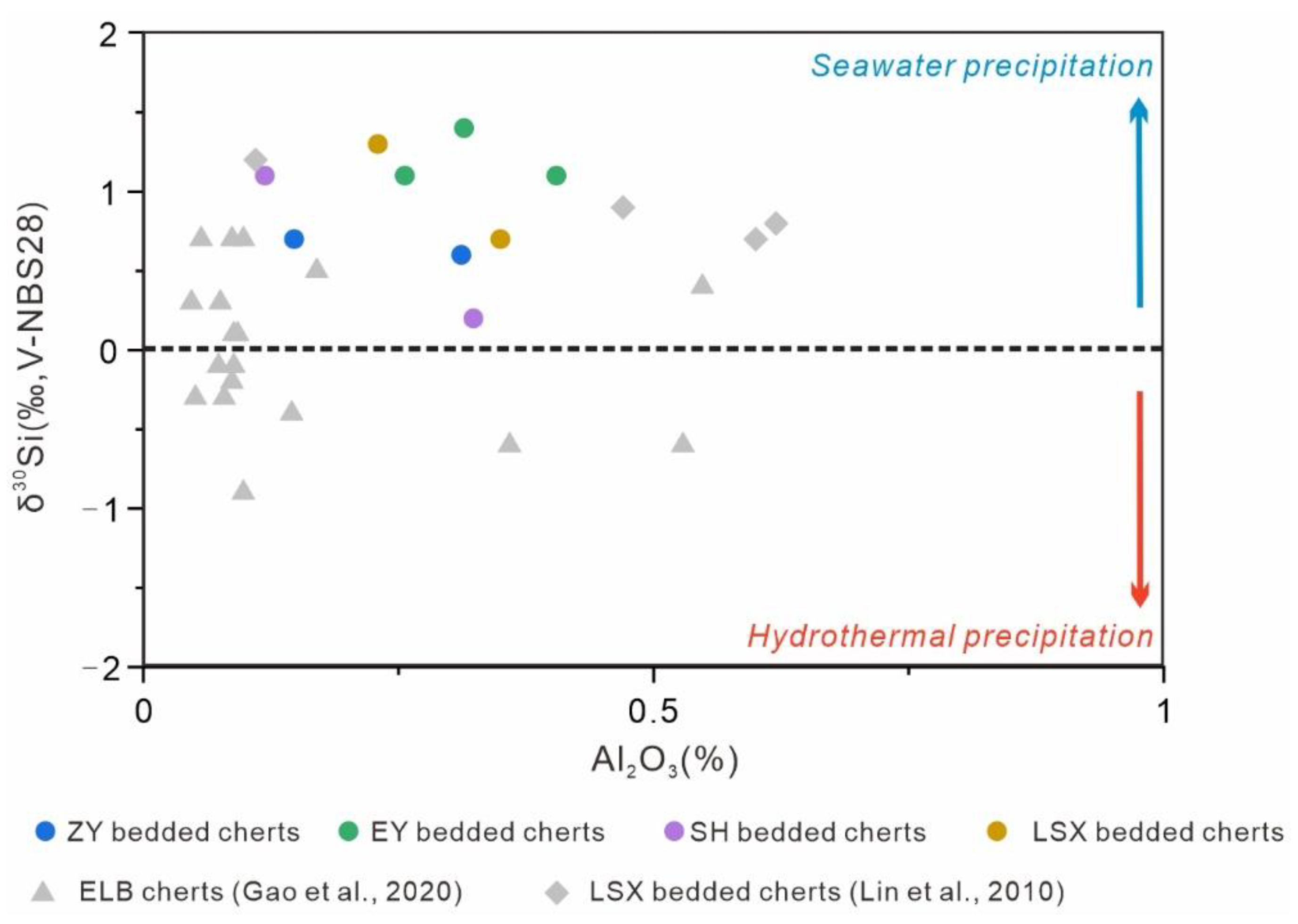
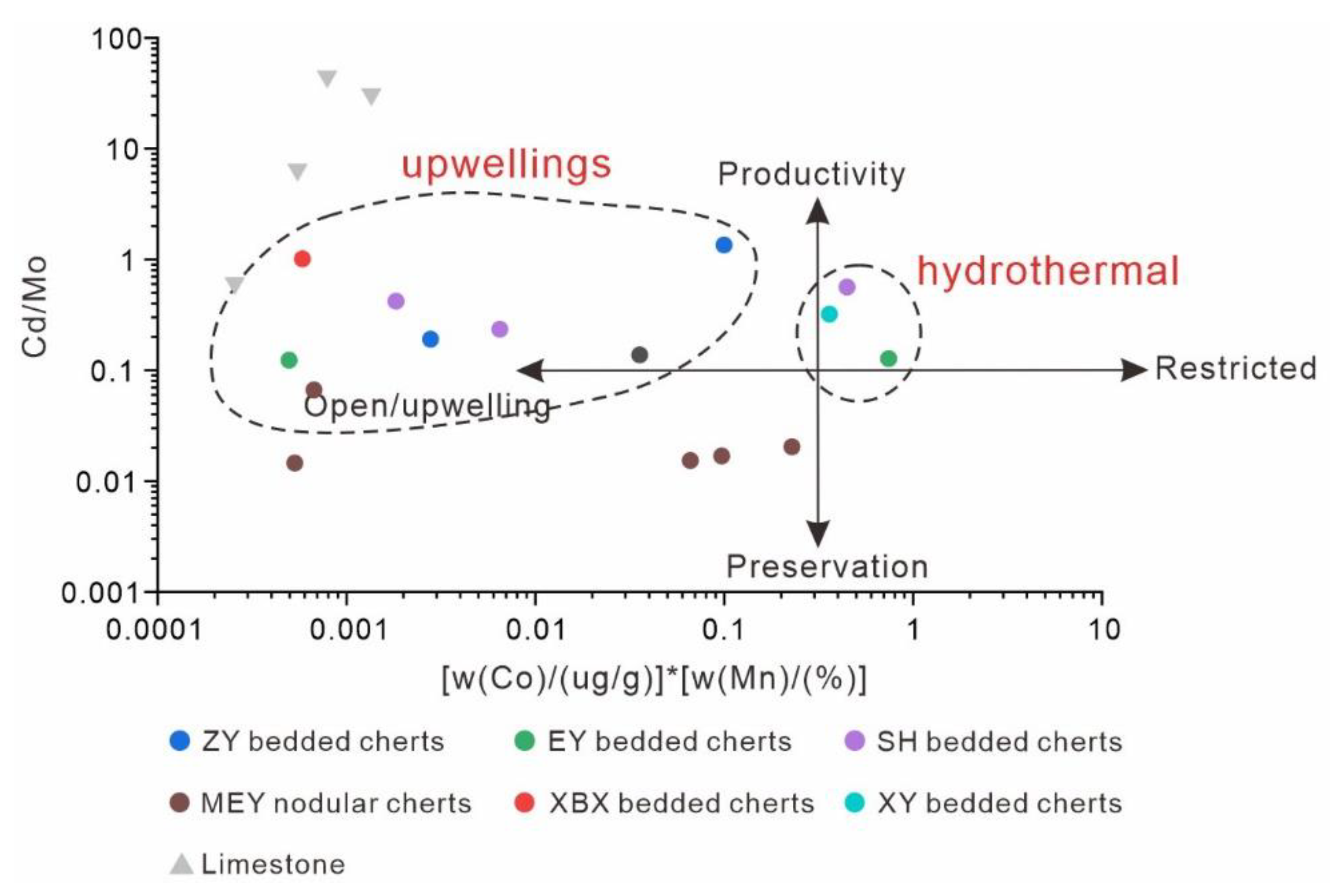

| Sample | Occurrence | SiO2 (wt%) | Al2O3 (wt%) | TFe2O3 (wt%) | CaO (wt%) | MgO (wt%) | K2O (wt%) | Na2O (wt%) | MnO (wt%) | TiO2 % | P2O5 (wt%) |
|---|---|---|---|---|---|---|---|---|---|---|---|
| EY-1 | bedded | 81.598 | 0.256 | 0.117 | 9.278 | 1.946 | 0.025 | 0.023 | 0.004 | 0.006 | 0.010 |
| EY-2 | bedded | 82.36 | 0.4 | 0.48 | 9.5 | 0.08 | 0.12 | 0.03 | 0.01 | 0.02 | 0.01 |
| EY-4 | bedded | 89.67 | 0.31 | 0.06 | 5.28 | 0.12 | 0.06 | 0.06 | 0 | 0.01 | 0.02 |
| LSX-4 | bedded | / | / | / | / | / | / | / | / | / | / |
| LSX-5 | bedded | / | / | / | / | / | / | / | / | / | / |
| LSX-1 | bedded | 77.96 | 0.1 | 0.18 | 11.5 | 1.21 | 0.03 | 0.06 | 0 | 0 | 0.02 |
| SH-1 | bedded | 82.68 | 0.32 | 0.22 | 6.87 | 2.19 | 0.05 | 0.03 | 0.01 | 0.01 | 0.01 |
| SH-3 | bedded | 92.73 | 0.12 | 0.04 | 3.36 | 0.1 | 0.03 | 0.03 | 0 | 0.01 | 0 |
| XBX-1 | bedded | 91.4 | 0.48 | 0.28 | 1.28 | 0.15 | 0.09 | 0.04 | 0 | 0.02 | 0.06 |
| ZY-1 | bedded | 92.4 | 0.15 | 0.16 | 4.01 | 0.03 | 0.02 | 0.03 | 0 | 0 | 0.02 |
| ZY-2 | bedded | 93.3 | 0.31 | 0.18 | 1.84 | 0.12 | 0.06 | 0.03 | 0.01 | 0.01 | 0.11 |
| CJG-1 | limestone | 0.115 | 0.05 | 0.04 | 55.2 | 0.61 | 0.01 | / | 0 | 0.01 | 0 |
| EY-3 | limestone | 0.197 | 0.04 | 0.03 | 55.5 | 0.34 | 0.01 | / | / | / | / |
| LSX-2 | limestone | 2.899 | 0.06 | 0.02 | 53.4 | 0.82 | 0.01 | / | 0 | 0 | 0 |
| SDZ-1 | limestone | 0.113 | 0.04 | 0.04 | 56 | 0.35 | 0.01 | / | / | / | / |
| XY-2 | limestone | 0.326 | 0.05 | 0.02 | 55.4 | 0.73 | 0.01 | / | / | / | 0 |
| ZY-3 | limestone | 0.361 | 0.09 | 0.05 | 54.6 | 0.95 | 0.01 | / | 0 | 0 | / |
| XY-1 | nodular | 79.49 | 1.19 | 0.26 | 6.58 | 3.3 | 0.01 | 0.03 | 0 | 0.05 | 0.03 |
| MET-1 | nodular | 74.89 | 0.06 | 0.2 | 12.5 | 2.61 | 0.01 | / | 0 | / | 0 |
| MET-2 | nodular | 98.13 | 0.19 | 0.14 | 0.16 | 0.02 | 0.04 | / | 0.01 | / | 0.01 |
| MET-3 | nodular | 87.14 | 0.19 | 1.51 | 4.75 | 1.45 | 0.04 | / | 0.18 | 0.01 | 0.01 |
| MET-4 | nodular | 97.3 | 0.22 | 0.83 | 0.39 | 0.01 | 0.04 | 0.01 | 0.08 | 0.01 | 0.03 |
| MET-5 | nodular | 89.55 | 0.28 | 0.81 | 2.2 | 0.14 | 0.04 | 0.06 | 0.07 | 0.03 | 0.01 |
| Sample | Occurrence | Cd(ppm) | Mo(ppm) | Mn(ppm) | Co(ppm) | δ30SiNBS-28‰ |
|---|---|---|---|---|---|---|
| EY-1 | bedded | 0.038 | 0.004 | 36.244 | 0.177 | 1.1 |
| EY-2 | bedded | 0.1 | 0.03 | 46.63 | 173 | 1.1 |
| EY-4 | bedded | / | / | / | / | 1.4 |
| LSX-4 | bedded | / | / | / | / | 1.3 |
| LSX-5 | bedded | / | / | / | / | 0.7 |
| LSX-1 | bedded | 0.14 | 0.01 | 15.01 | 297 | / |
| SH-1 | bedded | 0.97 | 0 | 74.56 | 0.69 | 0.2 |
| SH-3 | bedded | 0.07 | 0.02 | 15.18 | 397 | 1.1 |
| XBX-1 | bedded | 5.91 | 0.01 | 13.83 | 0.42 | / |
| ZY-1 | bedded | 0.04 | 0.01 | 3.941 | 83 | 0.7 |
| ZY-2 | bedded | 3.73 | 0.01 | 85.38 | 0.51 | 0.6 |
| CJG-1 | limestone | 0.26 | 0.01 | 35.9 | 0.52 | / |
| EY-3 | limestone | 0.1 | 0.01 | 6.353 | 0.71 | / |
| LSX-2 | limestone | 0.11 | 0 | 9.263 | 0.62 | / |
| SDZ-1 | limestone | 0.15 | 0.01 | 6.416 | 6.63 | / |
| XY-2 | limestone | 0.17 | 0 | 6.928 | 0.59 | / |
| ZY-3 | limestone | 0.29 | 0.01 | 11.33 | 0.66 | / |
| XY-1 | nodular | 0.23 | 0.52 | 16.54 | 28.7 | / |
| MET-1 | nodular | 0.12 | 1.8 | 19.7 | 0.33 | / |
| MET-2 | nodular | 0.03 | 1.86 | 34.59 | 0.09 | / |
| MET-3 | nodular | 0.06 | 3.4 | 1201 | 0.71 | / |
| MET-4 | nodular | 0.06 | 3.97 | 653.5 | 1.12 | / |
| MET-5 | nodular | / | / | / | / | / |
| MET-6 | nodular | 0.104 | 5.110 | 1033.166 | 2.165 | / |
| Sample | Occurrence | La | Ce | Pr | Nd | Sm | Eu | Gd | Tb | Dy | Ho | Er | Tm | Yb | Lu | ΣREE | Ce/Ce* | Eu/Eu* |
|---|---|---|---|---|---|---|---|---|---|---|---|---|---|---|---|---|---|---|
| EY-2 | bedded | 0.491 | 0.898 | 0.114 | 0.414 | 0.091 | 0.022 | 0.085 | 0.013 | 0.082 | 0.017 | 0.050 | 0.007 | 0.053 | 0.008 | 2.347 | 0.915 | 1.341 |
| LSX-1 | bedded | 0.082 | 0.170 | 0.022 | 0.087 | 0.023 | 0.012 | 0.022 | 0.004 | 0.021 | 0.004 | 0.012 | 0.002 | 0.012 | 0.002 | 0.474 | 0.969 | 2.729 |
| SH-1 | bedded | 2.610 | 4.000 | 0.398 | 1.551 | 0.361 | 0.062 | 0.324 | 0.047 | 0.274 | 0.057 | 0.152 | 0.021 | 0.122 | 0.011 | 9.989 | 0.927 | 0.965 |
| SH-2 | bedded | 0.435 | 0.694 | 0.082 | 0.290 | 0.064 | 0.015 | 0.060 | 0.010 | 0.064 | 0.014 | 0.038 | 0.005 | 0.035 | 0.005 | 1.811 | 0.881 | 1.289 |
| SH-3 | bedded | 0.099 | 0.193 | 0.026 | 0.101 | 0.027 | 0.008 | 0.024 | 0.004 | 0.020 | 0.004 | 0.010 | 0.002 | 0.011 | 0.002 | 0.529 | 0.924 | 1.614 |
| XBX-1 | bedded | 4.047 | 7.057 | 0.704 | 2.489 | 0.605 | 0.106 | 0.563 | 0.085 | 0.520 | 0.115 | 0.344 | 0.049 | 0.329 | 0.129 | 17.143 | 0.998 | 0.974 |
| ZY-1 | bedded | 0.069 | 0.131 | 0.016 | 0.064 | 0.015 | 0.003 | 0.013 | 0.002 | 0.013 | 0.003 | 0.007 | 0.001 | 0.007 | 0.001 | 0.344 | 0.953 | 1.314 |
| ZY-2 | bedded | 2.778 | 4.503 | 0.462 | 1.792 | 0.451 | 0.078 | 0.445 | 0.064 | 0.359 | 0.075 | 0.200 | 0.029 | 0.177 | 0.055 | 11.469 | 0.947 | 0.946 |
| CJG-1 | limestone | 0.375 | 0.726 | 0.082 | 0.293 | 0.068 | 0.011 | 0.058 | 0.009 | 0.053 | 0.010 | 0.028 | 0.004 | 0.023 | 0.003 | 1.745 | 1.000 | 0.939 |
| EY-3 | limestone | 0.321 | 0.589 | 0.066 | 0.221 | 0.049 | 0.008 | 0.041 | 0.006 | 0.040 | 0.009 | 0.026 | 0.004 | 0.027 | 0.004 | 1.411 | 0.977 | 0.923 |
| LSX-2 | limestone | 0.177 | 0.332 | 0.039 | 0.147 | 0.035 | 0.006 | 0.032 | 0.006 | 0.038 | 0.009 | 0.027 | 0.004 | 0.031 | 0.004 | 0.886 | 0.962 | 1.006 |
| SDZ-1 | limestone | 0.414 | 0.775 | 0.095 | 0.343 | 0.082 | 0.013 | 0.072 | 0.010 | 0.058 | 0.012 | 0.033 | 0.005 | 0.033 | 0.005 | 1.951 | 0.942 | 0.922 |
| XY-2 | limestone | 0.117 | 0.221 | 0.028 | 0.105 | 0.025 | 0.004 | 0.023 | 0.004 | 0.024 | 0.006 | 0.017 | 0.003 | 0.020 | 0.006 | 0.603 | 0.937 | 0.807 |
| ZY-3 | limestone | 0.282 | 0.595 | 0.076 | 0.262 | 0.055 | 0.008 | 0.044 | 0.007 | 0.040 | 0.008 | 0.025 | 0.004 | 0.027 | 0.006 | 1.440 | 0.977 | 0.857 |
| MET-2 | nodular | 0.081 | 0.145 | 0.017 | 0.064 | 0.016 | 0.025 | 0.012 | 0.002 | 0.009 | 0.002 | 0.005 | 0.001 | 0.005 | 0.001 | 0.385 | 0.941 | 9.433 |
| MET-3 | nodular | 0.135 | 0.304 | 0.041 | 0.160 | 0.042 | 0.042 | 0.040 | 0.006 | 0.037 | 0.007 | 0.020 | 0.003 | 0.020 | 0.003 | 0.862 | 0.979 | 5.471 |
| MET-4 | nodular | 0.225 | 0.457 | 0.057 | 0.221 | 0.058 | 0.052 | 0.054 | 0.008 | 0.041 | 0.007 | 0.016 | 0.002 | 0.014 | 0.002 | 1.213 | 0.970 | 4.945 |
| MET-6 | nodular | 1.678 | 3.151 | 0.360 | 1.414 | 0.361 | 0.110 | 0.353 | 0.056 | 0.341 | 0.070 | 0.193 | 0.029 | 0.188 | 0.029 | 8.333 | 0.976 | 1.660 |
Publisher’s Note: MDPI stays neutral with regard to jurisdictional claims in published maps and institutional affiliations. |
© 2021 by the authors. Licensee MDPI, Basel, Switzerland. This article is an open access article distributed under the terms and conditions of the Creative Commons Attribution (CC BY) license (https://creativecommons.org/licenses/by/4.0/).
Share and Cite
Zheng, H.; Wu, J.; Tang, H.; Liu, B.; Yang, X.; Shi, K.; Luo, K.; Qiu, Q.; Dong, Y. Origin of the Multiple-Sourced Cherts in Maokou Carbonates in Sichuan Basin, South China. Minerals 2021, 11, 1269. https://doi.org/10.3390/min11111269
Zheng H, Wu J, Tang H, Liu B, Yang X, Shi K, Luo K, Qiu Q, Dong Y. Origin of the Multiple-Sourced Cherts in Maokou Carbonates in Sichuan Basin, South China. Minerals. 2021; 11(11):1269. https://doi.org/10.3390/min11111269
Chicago/Turabian StyleZheng, Haofu, Junfeng Wu, Hailei Tang, Bo Liu, Xiangyang Yang, Kaibo Shi, Kaiping Luo, Qi Qiu, and Yixin Dong. 2021. "Origin of the Multiple-Sourced Cherts in Maokou Carbonates in Sichuan Basin, South China" Minerals 11, no. 11: 1269. https://doi.org/10.3390/min11111269
APA StyleZheng, H., Wu, J., Tang, H., Liu, B., Yang, X., Shi, K., Luo, K., Qiu, Q., & Dong, Y. (2021). Origin of the Multiple-Sourced Cherts in Maokou Carbonates in Sichuan Basin, South China. Minerals, 11(11), 1269. https://doi.org/10.3390/min11111269





